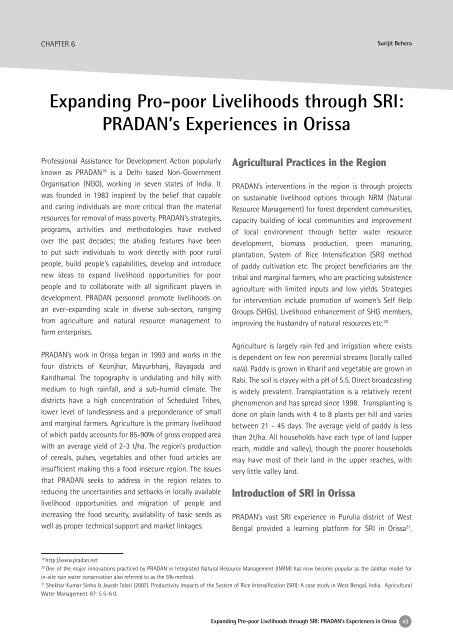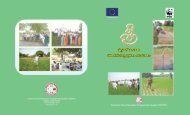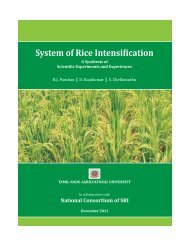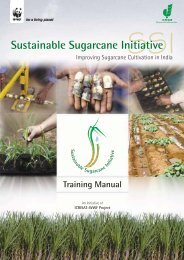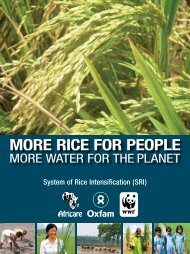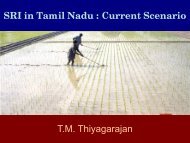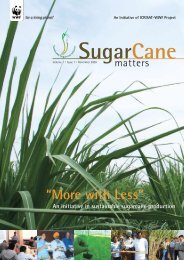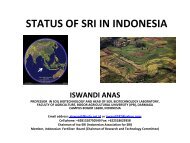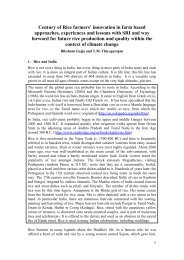SRI in Orissa - Cornell International Institute for Food, Agriculture ...
SRI in Orissa - Cornell International Institute for Food, Agriculture ...
SRI in Orissa - Cornell International Institute for Food, Agriculture ...
Create successful ePaper yourself
Turn your PDF publications into a flip-book with our unique Google optimized e-Paper software.
CHAPTER 6<br />
Surijit Behera<br />
Expand<strong>in</strong>g Pro-poor Livelihoods through <strong>SRI</strong>:<br />
PRADAN’s Experiences <strong>in</strong> <strong>Orissa</strong><br />
Professional Assistance <strong>for</strong> Development Action popularly<br />
known as PRADAN 19 is a Delhi based Non-Government<br />
Organisation (NGO), work<strong>in</strong>g <strong>in</strong> seven states of India. It<br />
was founded <strong>in</strong> 1983 <strong>in</strong>spired by the belief that capable<br />
and car<strong>in</strong>g <strong>in</strong>dividuals are more critical than the material<br />
resources <strong>for</strong> removal of mass poverty. PRADAN’s strategies,<br />
programs, activities and methodologies have evolved<br />
over the past decades; the abid<strong>in</strong>g features have been<br />
to put such <strong>in</strong>dividuals to work directly with poor rural<br />
people, build people’s capabilities, develop and <strong>in</strong>troduce<br />
new ideas to expand livelihood opportunities <strong>for</strong> poor<br />
people and to collaborate with all significant players <strong>in</strong><br />
development. PRADAN personnel promote livelihoods on<br />
an ever-expand<strong>in</strong>g scale <strong>in</strong> diverse sub-sectors, rang<strong>in</strong>g<br />
from agriculture and natural resource management to<br />
farm enterprises.<br />
PRADAN’s work <strong>in</strong> <strong>Orissa</strong> began <strong>in</strong> 1993 and works <strong>in</strong> the<br />
four districts of Keonjhar, Mayurbhanj, Rayagada and<br />
Kandhamal. The topography is undulat<strong>in</strong>g and hilly with<br />
medium to high ra<strong>in</strong>fall, and a sub-humid climate. The<br />
districts have a high concentration of Scheduled Tribes,<br />
lower level of landlessness and a preponderance of small<br />
and marg<strong>in</strong>al farmers. <strong>Agriculture</strong> is the primary livelihood<br />
of which paddy accounts <strong>for</strong> 85-90% of gross cropped area<br />
with an average yield of 2-3 t/ha. The region’s production<br />
of cereals, pulses, vegetables and other food articles are<br />
<strong>in</strong>sufficient mak<strong>in</strong>g this a food <strong>in</strong>secure region. The issues<br />
that PRADAN seeks to address <strong>in</strong> the region relates to<br />
reduc<strong>in</strong>g the uncerta<strong>in</strong>ties and setbacks <strong>in</strong> locally available<br />
livelihood opportunities and migration of people and<br />
<strong>in</strong>creas<strong>in</strong>g the food security, availability of basic seeds as<br />
well as proper technical support and market l<strong>in</strong>kages.<br />
Agricultural Practices <strong>in</strong> the Region<br />
PRADAN’s <strong>in</strong>terventions <strong>in</strong> the region is through projects<br />
on susta<strong>in</strong>able livelihood options through NRM (Natural<br />
Resource Management) <strong>for</strong> <strong>for</strong>est dependent communities,<br />
capacity build<strong>in</strong>g of local communities and improvement<br />
of local environment through better water resource<br />
development, biomass production, green manur<strong>in</strong>g,<br />
plantation, System of Rice Intensification (<strong>SRI</strong>) method<br />
of paddy cultivation etc. The project beneficiaries are the<br />
tribal and marg<strong>in</strong>al farmers, who are practic<strong>in</strong>g subsistence<br />
agriculture with limited <strong>in</strong>puts and low yields. Strategies<br />
<strong>for</strong> <strong>in</strong>tervention <strong>in</strong>clude promotion of women’s Self Help<br />
Groups (SHGs), Livelihood enhancement of SHG members,<br />
improv<strong>in</strong>g the husbandry of natural resources etc. 20<br />
<strong>Agriculture</strong> is largely ra<strong>in</strong> fed and irrigation where exists<br />
is dependent on few non perennial streams (locally called<br />
nala). Paddy is grown <strong>in</strong> Kharif and vegetable are grown <strong>in</strong><br />
Rabi. The soil is clayey with a pH of 5.5. Direct broadcast<strong>in</strong>g<br />
is widely prevalent. Transplantation is a relatively recent<br />
phenomenon and has spread s<strong>in</strong>ce 1998. Transplant<strong>in</strong>g is<br />
done on pla<strong>in</strong> lands with 4 to 8 plants per hill and varies<br />
between 21 - 45 days. The average yield of paddy is less<br />
than 2t/ha. All households have each type of land (upper<br />
reach, middle and valley), though the poorer households<br />
may have most of their land <strong>in</strong> the upper reaches, with<br />
very little valley land.<br />
Introduction of <strong>SRI</strong> <strong>in</strong> <strong>Orissa</strong><br />
PRADAN’s vast <strong>SRI</strong> experience <strong>in</strong> Purulia district of West<br />
Bengal provided a learn<strong>in</strong>g plat<strong>for</strong>m <strong>for</strong> <strong>SRI</strong> <strong>in</strong> <strong>Orissa</strong> 21 .<br />
19<br />
http://www.pradan.net<br />
20<br />
One of the major <strong>in</strong>novations practiced by PRADAN <strong>in</strong> Integrated Natural Resource Management (INRM) has now become popular as the Jaldhar model <strong>for</strong><br />
<strong>in</strong>-site ra<strong>in</strong> water conservation also referred to as the 5% method.<br />
21<br />
Shekhar Kumar S<strong>in</strong>ha & Jayesh Talati (2007). Productivity impacts of the System of Rice Intensification (<strong>SRI</strong>): A case study <strong>in</strong> West Bengal, India. Agricultural<br />
Water Management. 87: 5 5–6 0.<br />
Expand<strong>in</strong>g Pro-poor Livelihoods through <strong>SRI</strong>: PRADAN’s Experiences <strong>in</strong> <strong>Orissa</strong> 43


